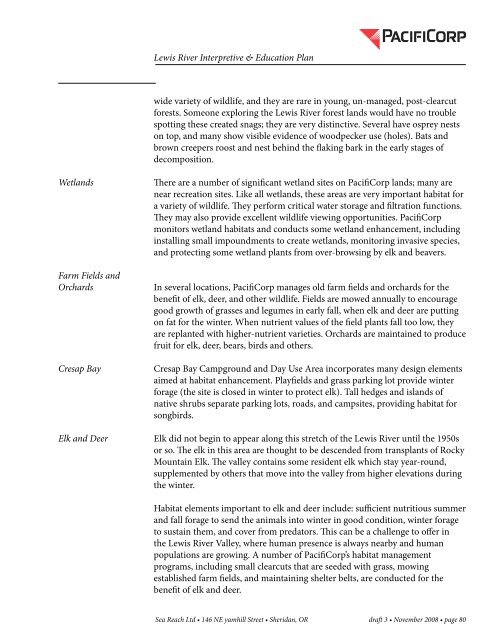The Lewis River Hydroelectric Projects - PacifiCorp
The Lewis River Hydroelectric Projects - PacifiCorp
The Lewis River Hydroelectric Projects - PacifiCorp
Create successful ePaper yourself
Turn your PDF publications into a flip-book with our unique Google optimized e-Paper software.
<strong>Lewis</strong> <strong>River</strong> Interpretive & Education Plan<br />
wide variety of wildlife, and they are rare in young, un-managed, post-clearcut<br />
forests. Someone exploring the <strong>Lewis</strong> <strong>River</strong> forest lands would have no trouble<br />
spotting these created snags; they are very distinctive. Several have osprey nests<br />
on top, and many show visible evidence of woodpecker use (holes). Bats and<br />
brown creepers roost and nest behind the flaking bark in the early stages of<br />
decomposition.<br />
Wetlands<br />
Farm Fields and<br />
Orchards<br />
Cresap Bay<br />
Elk and Deer<br />
<strong>The</strong>re are a number of significant wetland sites on <strong>PacifiCorp</strong> lands; many are<br />
near recreation sites. Like all wetlands, these areas are very important habitat for<br />
a variety of wildlife. <strong>The</strong>y perform critical water storage and filtration functions.<br />
<strong>The</strong>y may also provide excellent wildlife viewing opportunities. <strong>PacifiCorp</strong><br />
monitors wetland habitats and conducts some wetland enhancement, including<br />
installing small impoundments to create wetlands, monitoring invasive species,<br />
and protecting some wetland plants from over-browsing by elk and beavers.<br />
In several locations, <strong>PacifiCorp</strong> manages old farm fields and orchards for the<br />
benefit of elk, deer, and other wildlife. Fields are mowed annually to encourage<br />
good growth of grasses and legumes in early fall, when elk and deer are putting<br />
on fat for the winter. When nutrient values of the field plants fall too low, they<br />
are replanted with higher-nutrient varieties. Orchards are maintained to produce<br />
fruit for elk, deer, bears, birds and others.<br />
Cresap Bay Campground and Day Use Area incorporates many design elements<br />
aimed at habitat enhancement. Playfields and grass parking lot provide winter<br />
forage (the site is closed in winter to protect elk). Tall hedges and islands of<br />
native shrubs separate parking lots, roads, and campsites, providing habitat for<br />
songbirds.<br />
Elk did not begin to appear along this stretch of the <strong>Lewis</strong> <strong>River</strong> until the 1950s<br />
or so. <strong>The</strong> elk in this area are thought to be descended from transplants of Rocky<br />
Mountain Elk. <strong>The</strong> valley contains some resident elk which stay year-round,<br />
supplemented by others that move into the valley from higher elevations during<br />
the winter.<br />
Habitat elements important to elk and deer include: sufficient nutritious summer<br />
and fall forage to send the animals into winter in good condition, winter forage<br />
to sustain them, and cover from predators. This can be a challenge to offer in<br />
the <strong>Lewis</strong> <strong>River</strong> Valley, where human presence is always nearby and human<br />
populations are growing. A number of <strong>PacifiCorp</strong>’s habitat management<br />
programs, including small clearcuts that are seeded with grass, mowing<br />
established farm fields, and maintaining shelter belts, are conducted for the<br />
benefit of elk and deer.<br />
Sea Reach Ltd • 146 NE yamhill Street • Sheridan, OR draft 3 • November 2008 • page 80
















